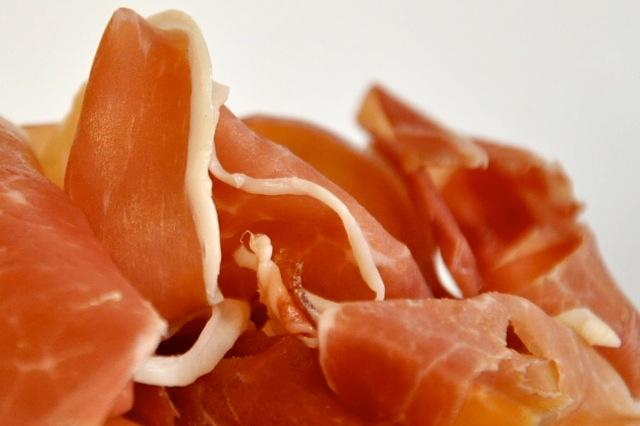 The origins of Prosciutto di San Daniele go back to Celtic-Roman times. In the Middle Ages, the town of San Daniele was a dependency of the Patriarchy of Aquileia whose Patriarch and Bishop-Count established his summer residence there and, exercising his feudal powers, demanded the payment of taxes in the form of ham. Prosciutto di San Daniele was served at the dining tables of the Council of Trent and was highly appreciated by princes and sovereigns. There are documents relating how in the seventeenth century a supply was sent to the King of Hungary accompanied by a health certificate drawn up by veterinarians from the Republic of Venice who had joined the Patriarchy of Aquileia. The large-scale production of Prosciutto di San Daniele began early this century. The ham became a favourite delicacy for a number of celebrated historical figures, Gabriele D'Annunzio among them. Prosciutto di San Daniele is an uncooked aged ham. It is distinctively shaped like a guitar and the meat is reddish-pink in colour. It has a pronounced aroma, a sweet and delicate flavour and an unmistakable after-taste. The retention of the end-piece of the hog's leg (the trotter) is another identifying characteristic. The treatment of the meat lasts 12-13 months. The area of production is the town district of San Daniele del Friuli in the province of Udine. The livestock comes exclusively from ten regions in central-north Italy (46 per cent from Lombardy alone). The hogs are bred only on approved farms, and the DOP certification sets out stringent norms regarding the genetic make-up of the animals and precise rules for their feeding. The only ingredient used in the treatment process is sea salt, and that only sparingly (the salt content in a properly aged Prosciutto di San Daniele is less than 6 per cent).
The origins of Prosciutto di San Daniele go back to Celtic-Roman times. In the Middle Ages, the town of San Daniele was a dependency of the Patriarchy of Aquileia whose Patriarch and Bishop-Count established his summer residence there and, exercising his feudal powers, demanded the payment of taxes in the form of ham. Prosciutto di San Daniele was served at the dining tables of the Council of Trent and was highly appreciated by princes and sovereigns. There are documents relating how in the seventeenth century a supply was sent to the King of Hungary accompanied by a health certificate drawn up by veterinarians from the Republic of Venice who had joined the Patriarchy of Aquileia. The large-scale production of Prosciutto di San Daniele began early this century. The ham became a favourite delicacy for a number of celebrated historical figures, Gabriele D'Annunzio among them. Prosciutto di San Daniele is an uncooked aged ham. It is distinctively shaped like a guitar and the meat is reddish-pink in colour. It has a pronounced aroma, a sweet and delicate flavour and an unmistakable after-taste. The retention of the end-piece of the hog's leg (the trotter) is another identifying characteristic. The treatment of the meat lasts 12-13 months. The area of production is the town district of San Daniele del Friuli in the province of Udine. The livestock comes exclusively from ten regions in central-north Italy (46 per cent from Lombardy alone). The hogs are bred only on approved farms, and the DOP certification sets out stringent norms regarding the genetic make-up of the animals and precise rules for their feeding. The only ingredient used in the treatment process is sea salt, and that only sparingly (the salt content in a properly aged Prosciutto di San Daniele is less than 6 per cent).

